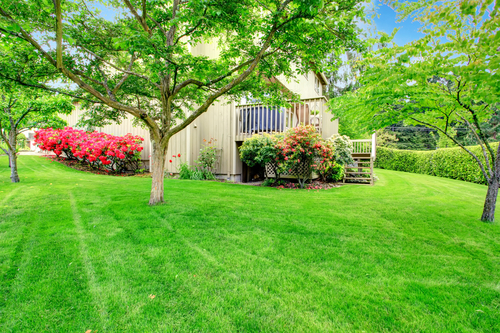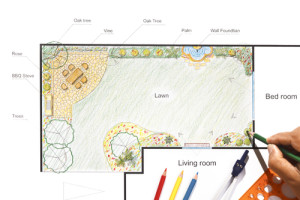Posts Tagged garden design
Backyard Ideas: 5 Easy Tips for Creating a Beautiful Drought-Resistant Back Yard
Earlier this year California made permanent the water restrictions that had been in place throughout the drought. While many people re-landscaped their front yards during the dry years, many more let their back yard lawns wither away, or removed them completely. But efficient, non-wasteful irrigation doesn’t mean you can’t enjoy a beautiful back yard retreat.
Xeriscaping, or water-wise, climate appropriate gardening, can allow you to have all the color, blooms, and lushness you desire while significantly reducing water use and maintenance. Try one or more of these 5 backyard ideas that are ideal for the dry summers and wet winter Mediterranean climate of Sonoma County.
Low-maintenance backyard ideas

Landscaping your back yard with waterwise techniques is not only environmentally friendly, it can be downright gorgeous. Here’s how.
Native plants
Always a good choice for xeriscape principles, climate-appropriate plantings are those that are suited to your local water availability. Here in Sonoma, good native choices include
- Perennials like lavender, rosemary, Santa Barbara daisy, Mexican sage, verbena, catmint, and dusty miller.
- Annuals and bulbs that are well-adapted to drought-tolerant gardens. Think daffodils, irises, California poppies, larkspur, and alyssum.
- Vines that include climbers like wisteria, honeysuckle, grape, and potato vine.
- Drought-tolerant grasses such as fountain, blue oat, blue fescue, sedge, and deer grass.
- Aloe, agave, echeverias, and sedums are good succulent choices that cover a wide spectrum of the green palette.
Groundcovers
Groundcovers are a great replacement for lawns, help to prevent soil erosion, and add a lovely splash of color. Is your Sonoma back yard mostly sunny? Rockrose is a hardy choice that requires almost no care. More shade than sun? Try creeping barberry. It’s bright yellow flowers in mid spring and blue berries in early summer make this a real show-stopper.
Don’t forget the mulch. It helps to moderate soil temperature, curtail evaporative water loss, and keep the weeds out of sight. The most common mulches are chipped or shredded bark, but gravel and stone can also be used.
Hardscape
There’s nothing more low-maintenance than hardscape. Paved areas, retaining walls, and stone and brick pathways create a clean minimalist look that can be enhanced and added to depending on what style back yard you prefer. Try a walkway of pea gravel with stepping stones that leads from the deck to the garden. A stone patio or composite deck are ideal for backyard barbecues.
Decorative stone
Use a mix of different gravels throughout the backyard landscape for more visual appeal. Decorative stone like river rock comes in many different sizes, shapes, and colors. Together with decomposed granite, it’s a great choice for surrounding a water feature or filling a raised or flat bed.
Create multiple outdoor living spaces
A nice balance of plantings and outdoor living areas lets you extend your home’s footprint while having less grassy areas to maintain. Even less expansive back yards can have several smaller areas that offer lots of options for entertaining. One area can feature the grill, another the bar setup, and another can hold seating and dining options.
Just keep in mind that regular maintenance isn’t eliminated by xeriscaping. Fertilizing, pruning, and occasional weeding are all still required. Irrigation systems should be tested and adjusted according to the season. And pest management is a core practice of xeriscape ideology.
Learn More
If you’d rather spend less time taking care of your back yard and more time relaxing in it, or just want some more terrific backyard ideas for your own home, contact us today. We’d love to show you all the ways a water-smart backyard can be a beautiful one, too.
Garden Design for Clay Soils
 Clay soil is definitely an acquired taste for most gardeners, yet you might start swearing by clay soil once you hear some of the benefits listed below. First, though, what the heck is clay soil and how can it benefit your garden?
Clay soil is definitely an acquired taste for most gardeners, yet you might start swearing by clay soil once you hear some of the benefits listed below. First, though, what the heck is clay soil and how can it benefit your garden?
Clay Soil Vs. The Competition
Generally when you walk into a nursery, outdoors department or speak with a landscape maintenance company, you might be steered more towards silt soils or loam soils before clay. That’s because clay soil is composed of tiny plates or granules that can harden over time.
You’ve no doubt had the experience of plunking your shovel down into the ground, ready to get your garden going in the spring, and run up against clay. In spite of its hardness, though, clay soil is great for retaining moisture, nourishing your garden as well as retaining nutrients and fertilizers between individual clay particles.
Loam, relatedly, is a combination of clay, sand and silt and is very versatile, moldable and just easy for even inexperienced gardeners to work with.
Benefits of Clay
Part of the reason that loam soil is so moldable, to our main point, is that loam contains clay. The clay in the loam ensures that what you’re working with clumps into granules whereas the silt and clay components of loam help to retain moisture and nourish the plants in your garden.
Clay soil works wonderfully for annuals as well as perennial plants since the clay allows these plants to get a firm (and nourishing!) hold with their roots. The grip that perennials and annuals get with clay can withstand otherwise harsh humidity and temperature changes.
In short, clay’s fantastic as a garden design foundation since it provides a hearty root structure and allows plants to withstand harsh conditions. Moreover, you won’t need to water or fertilize as much with clay as with other soils. All good things.
Working with Clay Soil
Clay soil as a garden design foundation can accommodate a pretty wide range of shrubs, climbers, conifers and trees. Everything from popular conifers like ginkgo biloba and a deciduous evergreen like cotoneaster to rosa and fuchsia shrubs makes a great complement to clay soil.
To provide even more nutrients for these clay-compatible shrubs and conifers try adding a light mulch to your garden. Leafmold, composted bark and long manure work especially well with clay soil in terms of providing an easy-to-work-with mulch that does wonders for your plants.
Mulching Your Clay Foundation
When you actually get down to planting, mulching the plants up to three inches is a good idea for a few reasons.
Just a few inches down allows the right amount of moisture to hit your plants’ roots while tamping down weed growth and providing shielding from the elements.
One problem that people have with clay soil is that they sometimes overwater. Remember that clay soil retains water and moisture better than other garden foundations and, therefore, doesn’t need around-the-clock watering.
You’ll know that you’re doing too much watering when you notice a lot of the plants visibly retaining water and you notice globs of water on the clay surface the next day. These would both indicate that it’s time to cut back and let clay soil work its magic.
Creating the Perfect Garden
If you understand how clay’s small granules retain moisture and you know not to overwater, clay can offer a ton of benefits beyond more favored soil types.
You might consider planting eucalyptus trees, gorgeous flowering plants like bergenias and some of the conifers mentioned above for the perfect garden design. Contact Xeriscape today to get started.





